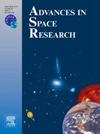A robust GNSS velocity estimation method combining Doppler and carrier phase observations in complex urban environments
IF 2.8
3区 地球科学
Q2 ASTRONOMY & ASTROPHYSICS
引用次数: 0
Abstract
Accurate and reliable velocity information is crucial for kinematic positioning, as it not only characterizes the carrier state but also serves as constraint information for positioning. However, due to the influence of low-cost Global Navigation Satellite System (GNSS) chips and complex environments, GNSS signals are prone to attenuation and interruptions. Consequently, frequent gross errors and cycle slips occur in observations, significantly degrading the velocity precision and reliability. To address this challenge, we have proposed a method combining Doppler and Time-Differenced Carrier Phase Velocity Estimation (D-TDCPVE). First, we assess the accuracy of both Doppler and carrier phase observations to determine the appropriate weight ratio for their combination. Second, we analyze the correlation between the two observation types and propose an adaptive parameter estimation strategy for estimating one or two clock bias variations to address their potential differences. Finally, we incorporate a combination of pre- and post-detection quality control measures along with additional cycle slip parameters to mitigate the impact of gross errors and cycle slips in complex environments. Experimental results conducted with three low-cost devices in urban environments demonstrate the superior performance of the D-TDCPVE method over both Doppler velocity estimation (DVE) and time-differenced carrier phase velocity estimation (TDCPVE). It enhances the success rate of velocity estimation by 3.3% to 20.1% compared to TDCPVE and improves velocity estimation accuracy by 16.1% to 60.9% compared to DVE. Moreover, the method does not necessitate the combination of dual-frequency observations, making it particularly valuable for cycle slip detection in scenarios involving mixed single- and dual-frequency observations, which is particularly useful in urban environments.
求助全文
约1分钟内获得全文
求助全文
来源期刊

Advances in Space Research
地学天文-地球科学综合
CiteScore
5.20
自引率
11.50%
发文量
800
审稿时长
5.8 months
期刊介绍:
The COSPAR publication Advances in Space Research (ASR) is an open journal covering all areas of space research including: space studies of the Earth''s surface, meteorology, climate, the Earth-Moon system, planets and small bodies of the solar system, upper atmospheres, ionospheres and magnetospheres of the Earth and planets including reference atmospheres, space plasmas in the solar system, astrophysics from space, materials sciences in space, fundamental physics in space, space debris, space weather, Earth observations of space phenomena, etc.
NB: Please note that manuscripts related to life sciences as related to space are no more accepted for submission to Advances in Space Research. Such manuscripts should now be submitted to the new COSPAR Journal Life Sciences in Space Research (LSSR).
All submissions are reviewed by two scientists in the field. COSPAR is an interdisciplinary scientific organization concerned with the progress of space research on an international scale. Operating under the rules of ICSU, COSPAR ignores political considerations and considers all questions solely from the scientific viewpoint.
 求助内容:
求助内容: 应助结果提醒方式:
应助结果提醒方式:


